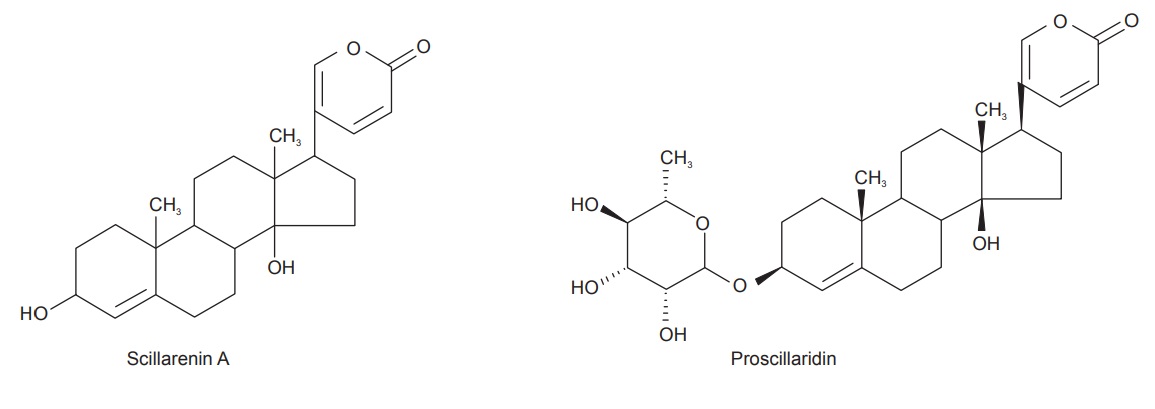Squill
| Home | | Pharmacognosy |Chapter: Pharmacognosy and Phytochemistry : Drugs Containing Glycosides
Squill consists of the dried slices of the bulb of white variety of Urginea maritima (Linn.) Baker, belonging to family Liliaceae.
SQUILL
Synonyms
Scillae Bulbus, Squill, Scilla Bulb, White Squill, European
Scilla, Urginea scilla, Drimia maritime.
Biological Source
Squill consists of the dried slices of the bulb of white
variety of Urginea maritima (Linn.)
Baker, belonging to family Liliaceae.
Geographical Source
It is mainly found in Spain, Portugal, Morocco, Algeria,
Corsica, southern France, Italy, Malta, Dalmatia, Greece, Syria and Asia.
Cultivation and Collection
The plant prefers light (sandy) and medium (loamy) soils and
requires well-drained soil. The plant prefers acid, neutral and basic
(alkaline) soils. It cannot grow in the shade. It requires dry or moist soil.
The plant can tolerate strong winds but not maritime exposure. Seeds are sown
as soon as it is ripe in a greenhouse. The seeds were sown thinly so that the
seedlings can be left in the pot for their first growing season. Fertilizers
are to be used regularly. Once the plant becomes dormant the young bulbs are
divided, placing two to three bulbs in each pot. After an year they are transplanted
to the field. Division of offsets is done in late summer when the bulb is
dormant. Larger bulbs can be replanted immediately into their permanent
positions. It is probably best to pot up smaller bulbs and grow them on in a
greenhouse for a year before planting them out when they are dormant in late
summer.
The bulb is large and 18–20 cm high with 12 cm to 15 cm in
diameter. Bulbs are dug out from the soil in the end of August and external
scaly leaves and central portion are removed. The slices are dried completely
in the sunlight or by heat of the stove. The drug is stored in airtight and
especially in moisture proof containers.
Characteristics
It is a perennial plant with fibrous roots proceeding from
the base of a large, tunicated, nearly globular bulb, 4–6 inches long, the
outer scales of which are thin and papery, red or orange-brown in colour. The
bulb, which is usually only half immersed in the sand, sends forth several
long, lanceolate, pointed, somewhat undulated, shining, dark-green leaves, when
fully grown, feet long. From the middle of the leaves, a round, smooth,
succulent flower-stem rises, from 1 to 2 feet high, terminating in a long,
close spike of whitish flowers, which stand on purplish peduncles, at the base
of each, is a narrow, twisted, deciduous floral leaf or bract.
The undried bulb is somewhat pear-shaped, and generally
about the size of a man’s fist, but often larger, weighing from 1/2 lb to more
than 4 lb It has the usual structure of a bulb, being formed of smooth juicy
scales, closely wrapped over one another. It has little odour, but its inner
scales have a mucilaginous, bitter, acrid taste, owing to the presence of
bitter glucosides. The dried slices are narrow, flattish, curved,
yellowish-white, or with a roseate hue, according to the variety of squill from
which they are obtained, from 1 to 2 inches long, more or less translucent.

Chemical Constituents
Squill contains cardiac glycosides of bufadienolides types,
scillaren A and B and enzyme scillatenase. The other con-stituents present are
glucoscillaren A (cardiac glycoside), proscillaridin A, flavonoid, mucilage,
volatile substances and sinistrin. The cardiac glycoside (glucoscillaren A) on
hydrolysis gives three glucose molecules, 2 molecules of glucose and a molecule
of rhamnose along with scillarenin. Scillaren A is crystalline and responsible
for the activity of the drug. Scillaren B is amorphous and its exact chemical
structure is not known. Scillaren-A on hydrolysis with enzyme yields
proscillaridin A and glucose. Proscillaridin A on further acid hydrolysis
yields the aglycone scillarenin A and rhamnose. If scillaren A is hydrolysed
with acid directly scillarenin A and an intermediary disaccharide scillabiose are
obtained; Scillabiose on hydrolysis yields glucose and rhamnose.

Chemical Tests
1. They show negative results for
Baljet test and Legal test.
2. The Lieberman’s sterol test is
positive in squill gly-cosides.
3. In the mesophyll region of squill,
mucliage, calcium oxalate and yellow colouring matter xanthoscillide are
present. Mucilage does not give colour reaction with ruthenium red but stains
red with corallin soda and pale yellow with iodine.
Uses
It is largely used for its stimulating, expectorant and
diuretic properties, and is also a cardiac tonic, acting in a similar manner to
digitalis, slowing and strengthening the pulse, though more irritating to the
gastrointestinal mucous membrane. It is considered most useful in chronic
bronchitis, catarrhal affections and asthma. It is a potential substitute for
foxglove in aiding a failing heart.
